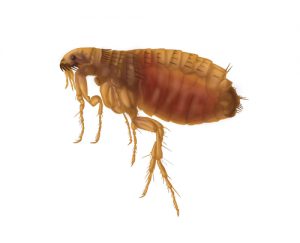Why Insects Jump
By Chris Williams on September 29, 2011.
In insects, there are two basic designs for those that use their legs to jump. Either you have long legs that provide leverage allowing you to cover a distance, or you have short legs that are able to release energy stored in the leg muscles to get you there. Grasshoppers are probably the first insect that comes to mind when the topic of jumping insects comes up. If you look at a grasshopper’s hind legs, it’s pretty apparent why it can jump so far. A grasshopper is a large insect with a powerful pair of jumping legs. In grasshoppers and crickets, one of their three pairs of legs are modified as jumping legs with large, muscular femurs (like thighs in a person). This jumping muscle propels the grasshopper at a speed of 10 feet per second to a distance of 20 times its body length.
 The much smaller flea is also known for its jumping ability. It can jump as high as 10 inches in the air, about 130 times its own body length. If a flea were the size of a human, it would be able to high jump 780 feet! Like the grasshopper, the flea has extra large femurs on its hind legs. But this isn’t the only reason why it can jump so far. The flea also stores an elastic protein in its joints which when released rapidly helps propel the flea forward like a spring.
The much smaller flea is also known for its jumping ability. It can jump as high as 10 inches in the air, about 130 times its own body length. If a flea were the size of a human, it would be able to high jump 780 feet! Like the grasshopper, the flea has extra large femurs on its hind legs. But this isn’t the only reason why it can jump so far. The flea also stores an elastic protein in its joints which when released rapidly helps propel the flea forward like a spring.
In insect jumping, distance isn’t everything; velocity counts, too. The spittlebug or froghopper, a plant-feeding bug, performs even better than the flea, and seems to be the all-round insect jumping champ. The spittlebug is the guy that leaves those little globs of frothy “spittle” on blades of grass. It can accelerate its body to a take-off velocity that is 4.7 times faster than a flea even though it is 27 times heavier than a flea with a body four times longer. The force exerted at takeoff is more than 400 times the spittlebug’s body weight. And once airborne, the flea’s distance can be reduced by 80% due to drag, compared to only 25% reduction experienced by the spittlebug. It’s thought that the spittlebug’s abilities evolved to help it escape attack from birds and other insects.
Jumping bristletails (a relative of the silverfish) live outdoors under leaves, bark, or rocks. These insects don’t have wings but, when disturbed, they are able to jump as far as 10 to 12 inches to escape the impending danger. Fortunately, silverfish which can become indoor pests, don’t have that same jumping ability.
Springtails are the tiniest jumpers and they do it without using their legs at all. Springtails are only about 1/16 inch long, barely visible to the naked eye, but they can jump about 20 times their length. Springtails get their name from a special, forked structure (called a furculum) on their abdomen which they extend downward and backward, using it like a spring or a catapult to launch themselves into the air. Springtails are very common outdoors in damp environments and sometimes become indoor pests in areas where there have been leaks or water damage.
Another insect that “jumps” without using its legs is the click beetle. Similar to the springtail, the click beetle jack-knifes a joint in its thorax to flip its body. It doesn’t go for the distance, but its random flips (accompanied by a click noise) are designed to startle would-be predators.
Jumping spiders aren’t insects (with 8 legs, not 6), but they have the ability to jump from 10 to 40 times their own body length when trying to catch insects or other arthropods.
Why have insects and spiders developed such marvelous jumping abilities? Some need to jump great distances to travel. Fleas need their jumping ability to be able to transfer from one animal to another or to leap onto a moving animal from the ground. Some insects, like springtails and bristletails, use their jumping ability to escape from predators. Some arthropods, like the jumping spider, are the predators themselves and jump to surprise and capture prey. Although jumping uses a lot of energy, particularly for the larger insects, it allows them to move more quickly than does running or flying. All of these jumpers have evolved their own unique mechanisms that allow them to launch themselves skyward.